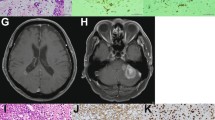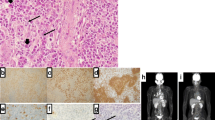Abstract
Epstein–Barr virus (EBV)-associated B-cell lymphoproliferative disorders occur at an increasing frequency in various hereditary and acquired states of immune dysfunction. In a few cases of T-cell lymphoma, especially in angioimmunoblastic T-cell lymphoma (AILT), EBV-associated B-cell lymphoproliferative disorders have been reported. Here, we present two cases of EBV-associated B-cell lymphoma after treatment of T-cell lymphoma (AILT and peripheral T-cell lymphoma, unspecified, PTCL-NOS) with a regimen containing alemtuzumab and fludarabine. Conventional and immunohistological tissue staining showed the typical features of highly proliferating diffuse large B-cell lymphoma in both cases. The monoclonal B-cell population displayed EBV latency type III. At the time of diagnosis the cellular immune status of both patients was severely compromised with an absolute CD4 T-cell count below <120 μl−1. Our observation supports the notion that combination of cytotoxic drugs and immunosuppressive antibodies in patients with T-cell lymphoma may severely aggravate the already present immunodeficiency. We suggest to monitor the cellular immune status in combination with the EBV load in high risk patients for early detection—and possibly intervention—of EBV-associated lymphoma.





Similar content being viewed by others
References
Louie S, Daoust PR, Schwartz RS. Immunodeficiency and the pathogenesis of non-Hodgkin’s lymphoma. Semin Oncol. 1980;7:267–84.
Buell JF, Gross TG, Woodle ES. Malignancy after transplantation. Transplantation. 2005;80(Suppl2):S254–64. doi:10.1097/01.tp.0000186382.81130.ba.
Rickinson AB, Moss DJ. Human cytotoxic T lymphocyte responses to Ebstein–Barr virus infection. Annu Rev Immunol. 1997;15:405–31. doi:10.1146/annurev.immunol.15.1.405.
Pizzolo G, Vinante F, Agostini C, Zambello R, Trentin L, Masciarelli M, et al. Immunologic abnormalities in angioimmunoblastic lymphadenopathy. Cancer. 1987;60:2412–8. doi:10.1002/1097-0142(19871115)60:10<2412::AID-CNCR2820601010>3.0.CO;2-F.
Zettl A, Lee SS, Rüdiger T, Starostik P, Marino M, Kirchner T, et al. Ebstein–Barr virus-associated B-cell lymphoproliferative disorders in angioimmunoblastic T-cell lymphoma and peripheral T-cell lymphoma, unspecified. M J Clin Pathol. 2002;117:368–79. doi:10.1309/6UTX-GVC0-12ND-JJEU.
Anagnostopoulos I, Hummel M, Finn T, Tiemann M, Korbjuhn P, Dimmler C, et al. Heterogenous Ebstein–Barr virus infection patterns in peripheral T-cell lymphoma of angioimmunoblastic lymphadenopathy type. Blood. 1992;80:1804–12.
Weiss LM, Jaffe ES, Liu XF, Chen YY, Shibata D, Medeiros LJ. Detection and localization of Ebstein–Barr viral genomes in angioimmunoblastic lymphadenopathy and angioimmunoblastic lymphadenopathy-like lymphoma. Blood. 1992;79:1789–95.
Willenbrock K, Brauninger A, Hansmann ML. Frequent occurrence of B-cell lymphomas in angioummunoblastic T-cell lymphoma and proliferation of Ebstein–Barr virus-infected cells in early cases. Br J Haematol. 2007;138:733–9. doi:10.1111/j.1365-2141.2007.06725.x.
Siegert W, Agthe A, Griesser H, Schwedtfeger R, Brittinger G, Engelhard M, et al. Treatment of angioimmunoblastic lymphadenopathy (AILD)-type T-cell lymphoma using prednisone with or without the COPBLAM/IMVP-16 regimen. A multicenter study. Kiel Lymphoma Study Group. Ann Intern Med. 1992;117:364–70.
Martin SI, Marty FM, Fiumara K, Treon SP, Gribben JG, Baden LR. Infectious complications associated with alemtuzumab use for lymphoproliferative disorders. Clin Infect Dis. 2006;43:16–24. doi:10.1086/504811.
Kurzrock R, Ravandi F. Purine analogues in advanced T-cell lymphoid malignancies. Semin Hematol. 2006;43Suppl 2(2):S27–34. doi:10.1053/j.seminhematol.2005.12.010.
Yawalkar N, Ferenczi K, Jones DA, Yamanaka K, Suh KY, Sadat S, et al. Profound loss of T-cell receptor repertoire complexity in cutaneous T-cell lymphoma. Blood. 2003;102:4059–66. doi:10.1182/blood-2003-04-1044.
Yamanaka K, Yawalkar N, Jones DA, Hurwitz D, Ferenczi K, Eapen S, et al. Decreased T-cell receptor excision circles in cutaneous T-cell lymphoma. Clin Cancer Res. 2005;11:5748–55. doi:10.1158/1078-0432.CCR-04-2514.
Zettl A, Lee SL, Rüdiger T, Starostik P, Marino M, Kirchner T, et al. Ebstein–Barr virus-associated B-cell lymphoproliferative disorders in angioimmunoblastic T-cell lymphoma and peripheral T-cell lymphoma, unspecified. Am J Clin Pathol. 2002;117:368–79. doi:10.1309/6UTX-GVC0-12ND-JJEU.
Hawley RC, Cankovic M, Zarbo RJ. Angioimmunoblastic T-cell lymphoma with supervening Ebstein–Barr virus-Associated Large B-cell Lymphoma. Arch Pathol Lab Med. 2006;130:1707–11.
Tobinai K, Ohtsu T, Hayashi M, Kinoshita T, Matsuno Y, Mukai K, et al. Ebstein–Barr virus (EBV) genome carrying monoclonal B-cell lymphoma in a patient with adult T-cell leukaemia-lymphoma. Leuk Res. 1991;15:837–46. doi:10.1016/0145-2126(91)90468-9.
Luzzatto F, Pruneri G, Benini E, Manzotti M, Laszlo D, Martinelli G, et al. Angioimmunoblastic T-cell lymphoma with hyperplastic germinal centers and a high content of EBV-infected large B-cells carrying IgH chain gene monoclonal rearrangement. Histopathology. 2005;46:464–6. doi:10.1111/j.1365-2559.2004.01997.x.
Lundin J, Kimby E, Bjoerkholm M, Broliden PA, Celsing F, Hjalmar V, et al. Phase II trial of subcutaneous anti-CD52 monoclonal antibody alemtuzumab (Campath-1H) as first-line treatment for patients with B-cell chronic lymphocytic leukaemia (B-CLL). Blood. 2002;100:768–73. doi:10.1182/blood-2002-01-0159.
Keating MJ, Flinn I, Jain V, Binet JL, Hillmen P, Byrd J, et al. Therapeutic role of alemtuzumab (Campath-1H) in patients who have failed fludarabine: results of a large international study. Blood. 2002;99:3554–61. doi:10.1182/blood.V99.10.3554.
Dearden CE, Matutes E, Cazin B, Tjonnfjord GE, Parreira A, Nomdedeu B, et al. High remission rate in T-cell prolymphocytic leukaemia with CAMPATH-1H. Blood. 2001;98:1721–6. doi:10.1182/blood.V98.6.1721.
Lundin J, Hagberg H, Repp R, Cavallin-Stahl E, Freden S, Juliusson G, et al. Phase 2 study of alemtuzumab (anti-CD52 antibody) in patients with advanced mycosis fungoides/Szezary syndrome. Blood. 2003;101:4267–72. doi:10.1182/blood-2002-09-2802.
Enblad G, Hagberg H, Erlanson M, Porwit Lundin J, MacDonald A, Repp R, et al. A pilot study of alemtuzumab (anti-CD52 monoclonal antibody) therapy for patients with relapsed or chemotherapy refractory peripheral T-cell lymphomas. Blood. 2004;103:2920–4. doi:10.1182/blood-2003-10-3389.
Lundin J, Porwit-McDonald A, Rossmann ED, Karlsson C, Edman P, Rezvany MR, et al. Cellular immune reconstitution after subcutaneous alemtuzumab (anti-CD52 monoclonal antibody CAMPATH-1H) treatment as first-line therapy for B-cell chronic lymphocytic leukaemia. Leukemia. 2004;18:484–90. doi:10.1038/sj.leu.2403258.
Nguyen DD, Cao TM, Dugan K, Starcher SA, Fechter RL, Coutre SE. Cytomegalovirus viremia during Campath-1H therapy for relapsed and refractory chronic lymphocytic leukaemia and prolymphocytic leukaemia. Clin Lymphoma. 2002;3:105–10.
Laurenti L, Piccioni P, Cattani P, Cingolani A, Efremov D, Chiusolo P, et al. Cytomegalovirus reactivation during alemtuzumab therapy for chronic lymphocytic leukaemia.: incidence and treatment with oral ganciclovir. Haematologica. 2004;89:1248–52.
Gibbs DS, Westerman D, McCormack C, Sexymour JF, Prince HM. Severe and prolonged myeloid haematopoietic toxicity with myelodysplastic features following alemtuzumab therapy in patients with peripheral T-cell lymphoproliferative disorders. Br J Haematol. 2005;130:87–91. doi:10.1111/j.1365-2141.2005.05570.x.
Thursky KA, Worth LJ, Seymour JF, Prince HM, Slavin MA. Spectrum of infection, risk and recommendations for prophylaxis and screening among patients with lymphoproliferative disorders treated with alemtuzumab. Br J Haematol. 2005;132:3–12. doi:10.1111/j.1365-2141.2005.05789.x.
Nosari A, Tedeschi A, Ricci F, Montillo M. Characteristics and stage of the underlying diseases could determine the risk of opportunistic infections in patients receiving alemtuzumab. Haematologica. 2008;93:e30–1 (online only).
Peleg AY, Husain S, Kwak EJ, Silveira FP, Ndirangu M, Tran J, et al. Opportunistic Infections in 547 organ transplant recipients receiving alemtuzumab, a humanized monoclonal CD52 antibody. Clin Infect Dis. 2007;44:204–12. doi:10.1086/510388.
Rai KR, Freter CE, Mercier RJ, Cooper MR, Mitchell BS, Stadtmauer EA, et al. Alemtuzumab in previously treated chronic lymphocytic leukaemia patients who also had received fludarabine. J Clin Oncol. 2002;20:3891–7. doi:10.1200/JCO.2002.06.119.
Ghobrial IM, Otteman LA. An EBV-positive lymphoproliferative disorder after therapy with alemtuzumab. N Engl J Med. 2003;349:2570–1. doi:10.1056/NEJM200312253492622.
Sebelin-Wulf K, Nguyen TD, Oertel S, Papp-Vary M, Trappe RU, Schulzki A, et al. Quantitative analysis of EBV-specific CD4/CD8 T cell numbers, absolute CD4/CD8 T cell numbers and EBV load in solid organ transplant recipients with PLTD. Transpl Immunol. 2007;17:203–10. doi:10.1016/j.trim.2006.10.006.
Kirk AD, Cherikh WS, Ring M, Burke G, Kaufman D, Knechtle SJ, et al. Dissociation of depletional induction and posttransplant lymphoproliferative disease in kidney recipients treated with alemtuzumab. Am J Transplant. 2007;7:2619–25. doi:10.1111/j.1600-6143.2007.01972.x.
Abruzzo LV, Rosales CM, Medeiros LJ, Vega F, Luthra R, Manning JT, et al. Ebstein–Barr virus-positive lymphoproliferative disorders arising in immunodeficient patients previously treated with fludarabine for low-grade B-cell neoplasms. Am J Surg Pathol. 2002;26:630–6. doi:10.1097/00000478-200205000-00009.
Milpied N, Vasseur B, Parquet N, Garnier JL, Antoine C, Quartier P, et al. Humanized anti-CD20 monoclonal antibody (rituximab) in post-transplant B-lymphoproliferative disorder: a retrospective analysis on 32 patients. Ann Oncol. 2000;11(Suppl1):113–6. doi:10.1023/A:1008372814223.
Kuehnle I, Huls MH, Liu Z, Semmelmann M, Krance RA, Brenner MK, et al. CD20 monoclonal antibody (rituximab) for therapy of Ebstein–Barr virus lymphoma after hematopoietic stem-cell transplantation. Blood. 2000;95:1502–5.
Wagner HJ, Cheng YC, Huls MH, Gee AP, Kuehnle I, Krance RA, et al. Prompt versus preemptive intervention for EBV lymphoproliferative disease. Blood. 2004;103:3979–81. doi:10.1182/blood-2003-12-4287.
Comoli P, Basso S, Zecca M, Pagliara D, Baldanti F, Bernardo ME, et al. Preemptive therapy of EBV-related lymphoproliferative disease after pediatric haploidentical stem cell transplantation. Am J Transplant. 2007;7:1648–55. doi:10.1111/j.1600-6143.2007.01823.x.
Kluin-Nelemans HC, Coenen JL, Boers JE, van Imhoff GW, Rosati S. EBV-positive immunodeficiency lymphoma after alemtuzumab-CHOP therapy for peripheral T-cell lymphoma. Blood. 2008 (epub ahead of print).
Acknowledgments
We thank Stefan Kröber for the excellent support in histopathological analyses of case 2.
Author information
Authors and Affiliations
Corresponding author
About this article
Cite this article
Weisel, K.C., Weidmann, E., Anagnostopoulos, I. et al. Epstein–Barr virus-associated B-cell lymphoma secondary to FCD-C therapy in patients with peripheral T-cell lymphoma. Int J Hematol 88, 434–440 (2008). https://doi.org/10.1007/s12185-008-0176-2
Received:
Revised:
Accepted:
Published:
Issue Date:
DOI: https://doi.org/10.1007/s12185-008-0176-2




